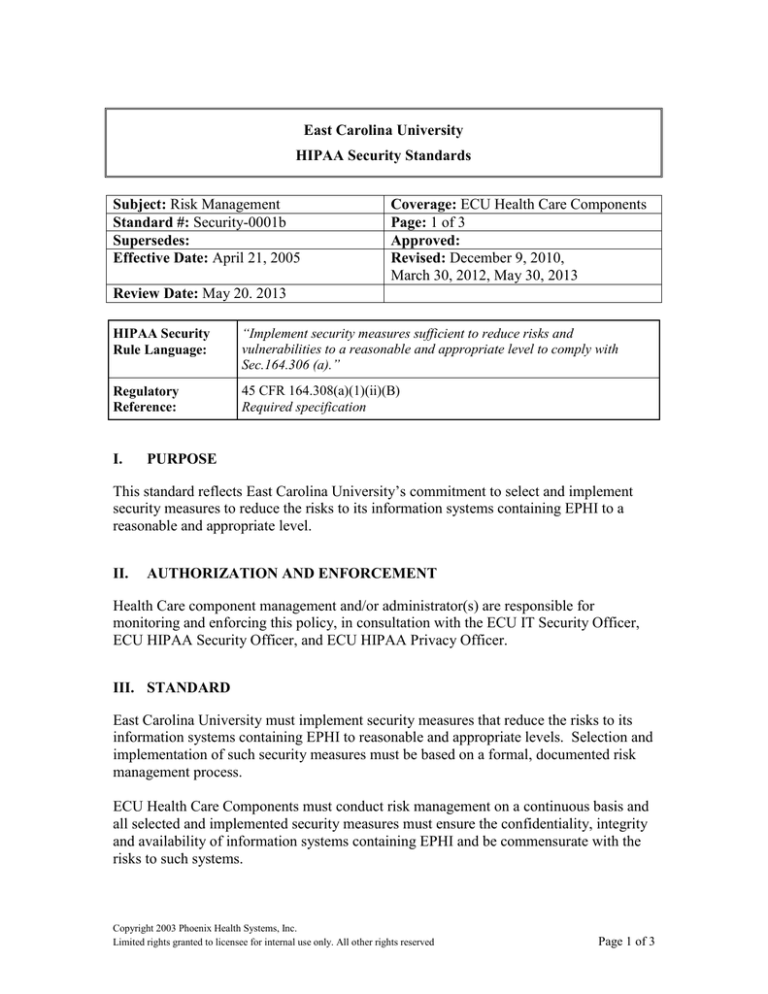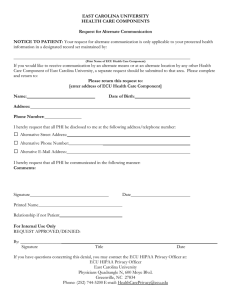
East Carolina University
HIPAA Security Standards
Subject: Risk Management
Standard #: Security-0001b
Supersedes:
Effective Date: April 21, 2005
Coverage: ECU Health Care Components
Page: 1 of 3
Approved:
Revised: December 9, 2010,
March 30, 2012, May 30, 2013
Review Date: May 20. 2013
HIPAA Security
Rule Language:
“Implement security measures sufficient to reduce risks and
vulnerabilities to a reasonable and appropriate level to comply with
Sec.164.306 (a).”
Regulatory
Reference:
45 CFR 164.308(a)(1)(ii)(B)
Required specification
I.
PURPOSE
This standard reflects East Carolina University’s commitment to select and implement
security measures to reduce the risks to its information systems containing EPHI to a
reasonable and appropriate level.
II.
AUTHORIZATION AND ENFORCEMENT
Health Care component management and/or administrator(s) are responsible for
monitoring and enforcing this policy, in consultation with the ECU IT Security Officer,
ECU HIPAA Security Officer, and ECU HIPAA Privacy Officer.
III. STANDARD
East Carolina University must implement security measures that reduce the risks to its
information systems containing EPHI to reasonable and appropriate levels. Selection and
implementation of such security measures must be based on a formal, documented risk
management process.
ECU Health Care Components must conduct risk management on a continuous basis and
all selected and implemented security measures must ensure the confidentiality, integrity
and availability of information systems containing EPHI and be commensurate with the
risks to such systems.
Copyright 2003 Phoenix Health Systems, Inc.
Limited rights granted to licensee for internal use only. All other rights reserved
Page 1 of 3
HIPAA Security Standard # 0001b: Risk Management
IV. APPLICABILITY
This standard is applicable to all workforce members who are responsible for or
otherwise administer a healthcare computing system. A healthcare computing system is
defined as a device or group of devices that store EPHI which is shared across the
network and accessed by healthcare workers.
V.
PROCEDURE
1. Security measures must be implemented to reduce the risks to information systems
containing EPHI to reasonable and appropriate levels. Selection and implementation
of such security measures must be based on a formal, documented risk management
process. At a minimum, the risk management process must include the following:
a. Assessment and prioritization of risks to information systems containing EPHI.
b. Selection and implementation of reasonable, appropriate and cost-effective
security measures to manage, mitigate, or accept identified risks.
c. Workforce member training and awareness on implemented security measures.
d. Regular evaluation and revision, as necessary, of existing security measures.
2. ECU Health Care Components must manage risk on a continuous basis and all
selected and implemented security measures must ensure the confidentiality, integrity
and availability of information systems containing EPHI. Strategies for managing
risk should be commensurate with the risk prioritization as described below to such
systems, using one or more of the following methods to manage risk: risk acceptance,
risk avoidance, risk limitation, or risk transference.
3. ECU Health Care Components’ risk management process must be based on the
following steps, which shall be formally documented and securely maintained:
a.
b.
c.
Inventory. ECU Health Care Components must conduct a regular inventory of
its information systems containing EPHI and the security measures protecting
those systems. ECU Health Care Components must be able to identify its
information systems and the relative value and importance of those systems.
Risk prioritization. Based on the risks defined by ECU Health Care
Components’ risk analysis, risks must be prioritized on a scale from high to low
based on the potential impact to information systems containing EPHI and the
probability of occurrence. When deciding what ECU resources should be
allocated to identified risks, highest priority must be given to those risks with
unacceptably high risk rankings.
Method selection. ECU Health Care Components must select the most
appropriate security methods to minimize or eliminate identified risks to
information systems containing EPHI. Such selections must be based on the
nature of a specific risk and the feasibility and effectiveness of a specific method.
Copyright 2003 Phoenix Health Systems, Inc.
Limited rights granted to licensee for internal use only. All other rights reserved
Page 2 of 3
HIPAA Security Standard # 0001b: Risk Management
d.
e.
f.
g.
Security method selection. ECU Health Care Components must determine the
most appropriate, reasonable and cost-effective security method(s) for reducing
identified risks to information systems containing EPHI.
Assignment of responsibility. ECU workforce members who have the
appropriate expertise must be identified and assigned responsibility for
implementing selected security method(s).
Security method implementation. Selected security method(s) must be
correctly implemented.
Security method evaluation. Selected security method(s) must be regularly
evaluated and revised as necessary.
VI. COORDINATING INSTRUCTION
1. All section policies, standards and procedures will be reviewed annually. Every
section policy, standards and procedure revision/replacement will be maintained for a
minimum of six years from the date of its creation or when it was last in effect,
whichever is later. Other East Carolina University, University of North Carolina
system, or state of North Carolina requirements may stipulate a longer retention.
Copyright 2003 Phoenix Health Systems, Inc.
Limited rights granted to licensee for internal use only. All other rights reserved
Page 3 of 3




